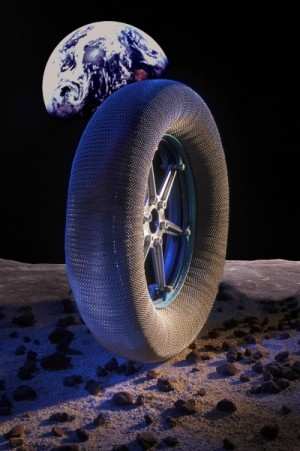Team Develops Energy Efficient Tire That Won't Go Flat
It sort of goes without saying that if you have a flat on the
moon, it's a long way to the nearest tire store. Not to mention air
is kind of at a premium. So NASA and The Goodyear Tire & Rubber
Company have developed an airless tire to transport large,
long-range vehicles across the surface of the moon.

The new "Spring Tire" with 800 load bearing springs is designed
to carry much heavier vehicles over much greater distances than the
wire mesh tire previously used on the Apollo Lunar Roving Vehicle
(LRV). The new tire will allow for broader exploration and the
eventual development and maintenance of a lunar outpost.
 According to Vivake Asnani, NASA's principal investigator at
the Glenn Research Center in Cleveland, this was a significant
change in requirements that required innovation. "With the combined
requirements of increased load and life, we needed to make a
fundamental change to the original moon tire," he said. "What the
Goodyear-NASA team developed is an innovative, yet simple network
of interwoven springs that does the job. The tire design seems
almost obvious in retrospect, as most good inventions do."
According to Vivake Asnani, NASA's principal investigator at
the Glenn Research Center in Cleveland, this was a significant
change in requirements that required innovation. "With the combined
requirements of increased load and life, we needed to make a
fundamental change to the original moon tire," he said. "What the
Goodyear-NASA team developed is an innovative, yet simple network
of interwoven springs that does the job. The tire design seems
almost obvious in retrospect, as most good inventions do."
The Spring Tire was installed on NASA's Lunar Electric Rover
test vehicle and put through its paces at the Johnson Space
Center's "Rock Yard" in Houston where it performed
successfully.
"This tire is extremely durable and extremely energy efficient,"
noted Jim Benzing, Goodyear's lead innovator on the project. "The
spring design contours to the surface on which it's driven to
provide traction. But all of the energy used to deform the tire is
returned when the springs rebound. It doesn't generate heat like a
normal tire."
 According to Goodyear engineers, development of the original
Apollo lunar mission tires, and the new Spring Tire were driven by
the fact that traditional rubber, pneumatic (air-filled) tires used
on Earth have little utility on the moon. This is because rubber
properties vary significantly between the extreme cold and hot
temperatures experienced in the shaded and directly sunlit areas of
the moon. Furthermore, unfiltered solar radiation degrades rubber,
and pneumatic tires pose an unacceptable risk of deflation.
According to Goodyear engineers, development of the original
Apollo lunar mission tires, and the new Spring Tire were driven by
the fact that traditional rubber, pneumatic (air-filled) tires used
on Earth have little utility on the moon. This is because rubber
properties vary significantly between the extreme cold and hot
temperatures experienced in the shaded and directly sunlit areas of
the moon. Furthermore, unfiltered solar radiation degrades rubber,
and pneumatic tires pose an unacceptable risk of deflation.
According to Asnani, the Spring Tire does not have a "single
point failure mode. What that means," he said, "is that a hard
impact that might cause a pneumatic tire to puncture and deflate
would only damage one of the 800 load bearing springs. Along with
having this ultra-redundant characteristic, the tire has a
combination of overall stiffness yet flexibility that allows
off-road vehicles to travel fast over rough terrain with relatively
little motion being transferred to the vehicle."
NASA has been so impressed with the tire that it decided to
highlight the project during NASA's recent "Day on the Hill"
exhibit at the Rayburn House Office Building in Washington, DC. "I
spoke with 10 to 15 members of Congress and about sixty staffers,"
noted NASA's Asnani. "Virtually everyone I spoke with was blown
away by the idea that this technology may one day be used, not only
for extraterrestrial vehicles, but also, perhaps, for vehicles here
on Earth."
 ANN's Daily Aero-Term (04.25.24): Airport Rotating Beacon
ANN's Daily Aero-Term (04.25.24): Airport Rotating Beacon ANN's Daily Aero-Linx (04.25.24)
ANN's Daily Aero-Linx (04.25.24) Klyde Morris (04.22.24)
Klyde Morris (04.22.24) Airborne 04.24.24: INTEGRAL E, Elixir USA, M700 RVSM
Airborne 04.24.24: INTEGRAL E, Elixir USA, M700 RVSM Airborne 04.22.24: Rotor X Worsens, Airport Fees 4 FNB?, USMC Drone Pilot
Airborne 04.22.24: Rotor X Worsens, Airport Fees 4 FNB?, USMC Drone Pilot





